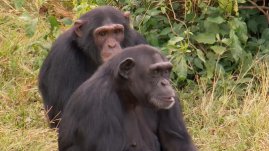Teachers' Domain - Digital Media for the Classroom and Professional Development
User: Preview

Source: The Human Spark: "Becoming Us"




Major funding for The Human Spark is provided by the National Science Foundation, and by the Alfred P. Sloan Foundation. Additional funding is provided by the John Templeton Foundation, the Cheryl and Philip Milstein Family, and The Winston Foundation.
ALAN ALDA (NARRATION) The great hope was that here might be a language gene – even the language gene – surely providing a wonderful insight into the Human Spark. The gene was identified here in the Oxford University lab of Simon Fisher. It’s called Fox P2, but the gene has nothing to do with foxes – although it did turn out to be present in many other creatures, from mice to fish.
SIMON FISHER You might think a gene that’s involved in speech and language might be unique to humans, but in fact this gene is surprisingly similar in lots of different species.
ALAN ALDA (NARRATION) Similar but not identical. The human form of the gene is a little different from the Fox P2 gene in chimpanzees, for instance, and even more different from the Fox P2 gene in mice. At least in most mice. These particular mice have been given the human Fox P2 gene, in an ambitious experiment aimed at finding out what exactly the human form of the gene is capable of.
I’ve come to the Max Planck Institute in Leipzig, Germany to meet the man behind the mice, Svante Pääbo.
SVANTE PÄÄBO The first question is, how do you analyze a mouse for speech? So we tried to speak to it a lot, and it never answered. So we had a big problem.
ALAN ALDA Well maybe you weren’t saying the right thing. What’s the second difference…
SVANTE PÄÄBO So the second just knocked us off our feet. They do vocalize differently.
ALAN ALDA They do? Whoa…
SVANTE PÄÄBO There is of course no way to say if they vocalize in a more human like way, but it’s different. ALAN ALDA (NARRATION) Male mice make high pitched squeaks when they’re around females – too high for the human ear, but their pitch can be altered in the computer so the trained ear can hear them. Compared to normal mice, the mice with the human gene squeak at a slightly lower pitch.
WOLFGANG ENARD This is clearly not that those mice can speak, but what it means is that the human form somehow impacts the neural circuits maybe that are involved in speech production.
SIMON FISHER My sense from the Fox P2 story is that Fox P2 was around for a long time, doing interesting things in the brains of our ancestors, and it was in the right place if you like to be recruited toward speech and language.
ALAN ALDA (NARRATION) This makes evolutionary sense, given that our Fox P2 is not the same as the chimp and mouse versions of the gene. In fact, the chimp Fox P2 is actually more similar to the version found in mice than it is to the one we humans have. This suggests that while Fox P2 may not be “the” language gene, it is one of the few genes scientists have identified that contribute to abilities we have and chimpanzees lack.
Scientists will undoubtedly find others.
 Loading Standards
Loading Standards